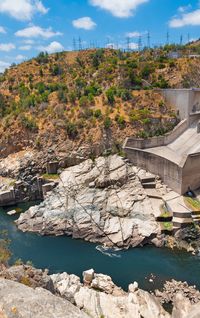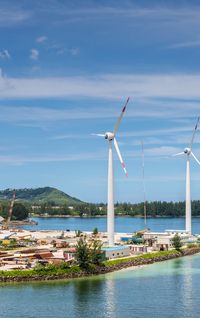India is considered an emerging market for offshore wind as it has immense potential in exploiting this sector to achieve its goal of net-zero by 2070. By Srdan Cenic, VP, head of offshore, Swapnil Rai, head, operational readiness, Prashant Shukla, head, product market strategy, Amar Variawa, chief specialist, business development, Fredrik Andren-Sandberg, head, public affairs and Anamika Chowdhury, analyst, strategy and market Intelligence, Vestas, APAC.
Globally, offshore wind with its super-efficient turbines, is an industry that is critical to the world’s decarbonisation goals. Mature markets in Europe such as Denmark have successfully utilised this industry over the years to get closer to their net-zero goals. Asia-Pacific, although a nascent market, is also picking up pace with developments under progress in South Korea, Taiwan, and Japan.
India’s Ministry of New & Renewable Energy (MNRE) published a revised strategy for offshore wind development in Q2 2023 outlining short-term and long-term targets, and three models to auction the targeted volume. A total 37GW of capacity is to be auctioned by 2030, with 7.2GW to be auctioned in 2024 and 2025. Auctions will be based on three models with and without viability gap funding, ie, subsidy schemes. So far, eight zones have been selected off the coasts of Tamil Nadu and Gujarat to develop the intended offshore wind farms, and another five zones have been proposed. Initial bids of 4GW are expected to be made in December 2023 with the auction being held in February 2024.
Current scenario
The offshore wind auction comes as good news as the expected increase in India’s energy consumption and the resulting peak in demand for electricity make offshore wind an advanced technology that will complement onshore wind and other sources of renewable energy generation needed to meet India’s power demand. There is going to be huge demand for offshore wind from commercial and industrial (C&I) players as their requirement for a continuous supply of energy is much higher than what onshore wind and solar energy can provide.
Offshore wind could also be useful in meeting the power-to-X and green hydrogen goals of India. It is expected that high offshore wind power demand will face capacity constraints due to limited turbine and component availability globally. In the long term, offshore wind will be a competitive and affordable choice for India to get clean near base-load power and energy security.
Currently, there is, however, no offshore wind in India. To get the offshore wind industry off the ground, current regulatory and support mechanisms need to be made more efficient and effective. This requires looking again at certain aspects of offshore wind strategy policy and considering more related factors that are crucial in seeing volumes being auctioned and projects installed to achieve the 2030 offshore wind target. As a global average for mature markets, it requires seven years for the first offshore power projects to reach maturity. For an emerging market such as India, it is expected to take longer. So, the time to act is now.
India can learn from its experience in the onshore wind industry, which is now picking up pace after a lull of almost five years. It is auctioning more volume and including storage as a parameter, and tariffs are also improving. Installations are also expected to pick up pace as the revised bidding guidelines state strict timelines for power purchase and power supply agreements (PPAs and PSAs) along with project commissioning deadlines. The onshore wind industry has learnt that unrealistic tariffs make auctions inefficient – a race to the bottom only makes project realisation even more difficult.
Turbine technology
India is expected to deploy 15MW fixed bottom turbines for its offshore wind farms to have a good business case. Developers will have to be extremely careful when selecting the product as reliable products will help minimise maintenance and servicing costs considerably. Offshore wind-related repairs can be 10 times more expensive than onshore wind repairs and can take a substantially longer time as they depends on the availability of critical equipment, vendors, specialised jack-up vessels, etc. This impacts the period of turbine downtime, hence substantially impacting the wind park economics.
Offshore turbines make up around 30%–40% of the overall offshore wind project investment depending on the location. So, the risks associated are much higher compared with onshore wind projects. But there is great maturity among key OEMs as far as offshore products are concerned. All major original equipment manufacturers (OEMs) have been successfully installing offshore wind turbines and completing projects of larger volumes in the more mature markets of the UK, Denmark, Taiwan, Japan, etc.
The end-to-end process – from local stakeholder engagement to commissioning – of offshore wind projects in less mature markets takes around 10 years to complete. This includes four to five years from auction to project commissioning. It is quite unclear where India is currently in terms of progress for the said timeline, so it may become a big possibility that the country will miss its 2030 target. Industry experts such as Wood Mackenzie believe that with the current status of progress, India will be able to install only 1%, or 300MW, of the target by 2030. A more bullish forecast also sees India missing its 2030 target with only 1.2GW installed1.
Subsidies and tariffs
Until now, a proper subsidy or viability gap funding threshold or ceiling has not been finalised by MNRE. As identified from the three different models of auctions, only 1GW will receive subsidies. The volume for subsidies has to be much higher to get developers interested. There will be less motivation in developing offshore wind, which is a cost premium technology that requires much higher capital investments. The offshore wind turbines are much more expensive to produce now as steel and other materials are costlier than before. In some cases, developers have faced cost increases of about 40% in the space of 1 to 1-1/2 years implying a significant hit to their costs.
Industry watchdogs estimate that the levellised cost of electricity (LCOE) for offshore wind in India can be expected to be US$210/MWh in 2030 compared with US$60/MWh for onshore wind. This will gradually decline to about US$68/MWh in 20502. Compared with this, according to unofficial estimates and internal sources, MNRE will offer a tariff of Rs4,000/MWh (US$48/MWh).
Industry participants and other sources feel the tariff should be at least doubled to make it viable for developers as the risks of developing an offshore wind project are way too high. While such tariffs will only interest developers when a thorough ramp-up of offshore installed volume is seen in India, it must be noted that onshore wind is still struggling there because of tariffs that are still lower than development costs. State support in terms of subsidies will be crucial to see offshore wind has tariffs that will match true development costs.
Considering developers are already pulling out of offshore projects or reducing business scale in more mature markets owing to delays, price increases, permitting complexities and other complications, and are becoming increasingly selective about which projects to go for, the above LCOE estimates, and tariff speculations do not come as good news to developers looking to expand their portfolios to India.
Similarly, the UK, the second largest offshore wind market after China, received zero bids for offshore wind in its September 2023 auction. Developers argued that the “price offered by the government – £44/MWh, or US$54.58/MWh – did not reflect rising industry costs”3. This is increasingly becoming a common issue affecting wind projects globally. So as to not repeat the same debacle of zero offshore wind investments in its next renewables auction to be held in March 2024, the UK has decided to increase the guaranteed price offered by 66% to £73/MWh, US$90.61/MWh)4.
Ecosystem and value chain
Developers have to lead the offshore wind value chain in India, and they will be supported by OEMs. But for this to happen, a strong ecosystem of ports, specialised vessels, offshore cables, local transportation suppliers, grid availability, etc, must be developed in advance. OEMs will begin supporting the value chain by sourcing turbines from their regional hubs until there is an increase in the pipeline or annual demand of 3GW–4GW for every two years from developers. This will also impact supply chain costs and delivery timelines.
Similarly, the availability of vessels will be influenced by yearly volumes and/or pipelines. The offshore supply chain and ecosystem will have to be much stronger than those in South Korea and Taiwan as these more experienced offshore markets are also suffering. India will ultimately be competing with these markets for the same limited resources and vessels.
The Indian infrastructure will have to be developed and strengthened significantly. First and foremost, grid and transmission infrastructure need to be developed to supply such high volumes of electricity. India still relies on a traditional grid developed for coal. Similarly, ports identified or selected for supporting the offshore wind ecosystem will have to be developed and made fit for all wind turbine pre-assembly activities.
Roads, too, must be developed, and transportation vehicles and safety equipment of world class standards need to be made available. Developing the surrounding ecosystem will take about three to four years. So, any further delays related to these developments will not only delay the estimated installation targets but will also lead to an increase in overall project costs.
Limited skill set
Globally, there is a constraint in the skill set available to get offshore wind power installed and maintained. This is also quite common in other Asia-Pacific offshore markets such as Taiwan and South Korea. India too will face this challenge. Not only is offshore wind a complicated technology with an even more complicated ecosystem, but it also requires continued upskilling to keep up with the challenges of setting up and servicing offshore wind farms over a longer period.
Considering that resources with the required skill set for offshore wind are concentrated in Europe, India will need to bring in these experts, technicians, engineers and heavy machinery operators with the desired skill sets from outside. This will again shoot up planning, development and O&M costs. Investments will also have to be made to provide the required training to have the right workforce with the desired technical, project management and other skills.
All this will have to be addressed in the first several years of project planning. As the market is still very nascent, the ramp-up of personnel will have to start much before offshore project installation commences to enable personnel mobilisation, training and site preparation before offshore installation vessels arrive. Safety and quality are also important aspects that will require special skill sets. This will again result in higher offshore wind project costs than in European regions. Other offshore wind markets in APAC are going through the same learnings.
Nearshore/inter-tidal
Until the framework around offshore wind in India is completely matured and there is a viable market route for developers, as an alternative, it would be more sensible for India to explore the nearshore/inter-tidal wind market and then incrementally shift its focus towards offshore wind. India should ramp up onshore wind volume, use the lessons learnt to build nearshore volume, mature its skill set, infrastructure and ecosystem, and then take up offshore wind.
Nearshore or inter-tidal projects are located relatively closer to the shore in shallow waters and are potentially cheaper to develop. Specific offshore expertise would still be required as safety, quality and execution timeline will be key enablers for successful project execution and should not be underestimated. Once developers gain confidence in nearshore wind development, the next natural area of exploration will be offshore projects in deeper waters.
Vietnam, in the Asia-Pacific region, has done this successfully because it realised early on that it would take a few more years before offshore wind made full economic sense to its market. It utilised the 2021 feed-in tariff expiry gold rush to develop nearshore wind projects. Vietnam saw a boom in nearshore projects between 2019 and 2021. It is now preparing to shift its focus towards offshore wind once all policy implementation plans and tariffs are approved by the government. In 2023, the Vietnamese government announced its Power Development Plan VIII (PDP 8) whereby it set itself an offshore wind target of 6GW by 2030.
While offshore wind investments will come mostly from international developers and financers, nearshore wind investments will interest both domestic and international developers. The playing field will increase significantly. Also, onshore wind turbine models of 7MW are suitable for nearshore projects, making the availability of wind turbines much cheaper.
India is a low wind speed market with winds blowing at ~7.3 m/s near the coasts. Nearshore projects in India can have fixed-bottom turbines installed near the coasts of Tamil Nadu towards Sri Lanka. These turbines are easier to install and maintain, cheaper than offshore turbines and the projects have lesser risks owing to their shorter development times. Moreover, most mature OEMs already have experience and success in installing nearshore projects in Vietnam.
Conclusion
The Indian offshore wind market has immense potential, but it is likely to be held back by challenges in the initial phase. The national target of 37GW by 2030 looks to be a daunting ask. Regulatory uncertainties, complexities in auction schemes and tariffs, short timelines for developers, complicated permitting rules and limited financial support will all pose challenges to the development of offshore wind in India. Offshore wind requires higher capital investments that could prove difficult to get developers interested in. India needs to learn from the struggles of onshore wind and implement lessons learnt before it can realise its offshore wind potential.
Nearshore or inter-tidal wind will be a much more realistic near-term target ,which will also keep developers and financers, both domestic and international, interested and engaged in India. Subsidies and tariffs, tax benefits, infrastructure development, simplified processes, etc, are important topics that have to be addressed. India needs to learn from the more mature markets in Asia-Pacific (South Korea, Taiwan) and globally, and foolproof its policies and implementation plans. Not only that, India needs to do better than most of these markets as these countries are now also beginning to see a slowdown in offshore wind growth. Offshore wind is a great idea for India that should be deployed next to onshore and nearshore wind.
Footnotes
1 - Wood Mackenzie’s 2030 outlook, Offshore wind market profile: India, version Q3 2023
2 - Wood Mackenzie’s OFSW competitiveness and LCOE forecasts, Offshore wind market profile: India, version Q3 2023
3 - Reuters, Offshore wind drops out of UK auction on costs, risking climate goals
4 - Reuters, Britain to boost offshore wind auction power price guarantees by 66%
To see the digital version of this report, please click here.
To purchase printed copies or a PDF of this report, please email leonie.welss@lseg.com














